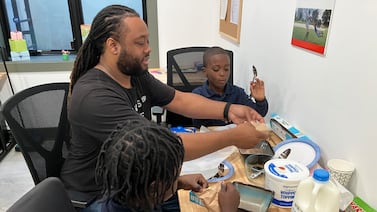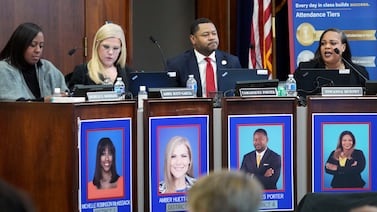Sign up for Chalkbeat Philadelphia’s free newsletter to keep up with the city’s public school system.
Funding to provide services for Philadelphia students experiencing homelessness was set to run out with the expiration of federal pandemic relief aid. But school and city leaders say they’re using district funds to extend those services for another year.
The district will replace the sunsetting American Rescue Plan money with $2.3 million in district funds for youth homeless services through June 2025, Superintendent Tony Watlington and City Council Education Chair Isiah Thomas announced Tuesday.
Without this money, Thomas said many of the nonprofit community groups that had been providing resources to vulnerable young people in partnership with the district were preparing to shut down, even as the number of vulnerable young people struggling to find housing is increasing.
“Today what we’re doing is just taking a small victory lap because we were able to avoid a crisis,” Thomas said at a City Hall press conference. “The work continues.”
The money will come from the school district’s operating budget. The district will distribute it to three community groups dedicated to supporting young people experiencing housing insecurity: Valley Youth House, HopePHL, and Eddie’s House.
The most recent data shows that 6,217 students were considered homeless in the 2022-2023 school year — a nearly 46% increase from the 2018-2019 school year. That number appears to have risen sharply again: For the 2023-24 school year, Quadirah Locus, program supervisor at Valley Youth House, said community groups have identified more than 10,000 homeless students so far.
At the press conference, city officials and housing advocates discussed the rising number of children without a stable home while standing behind a couch. The announcement comes as part of a citywide “Couches Don’t Count” campaign that launched in 2015.
The slogan references young people who lack a stable and consistent home and often “couch surf” at the homes of friends and acquaintances.
The partnership Thomas and Watlington committed to on Tuesday came after members of City Council sharply questioned district representatives at a youth homelessness hearing in July.
Thomas said Tuesday he “commends the district for stepping up,” and said the $2.3 million is a start. But he also said he’d like to see more money going to these efforts and to the school district in general to help hire more climate staff and school counselors.
Under the federal McKinney-Vento Homelessness Assistance Act, every school district and charter school must appoint a local homeless education liaison to identify students experiencing homelessness and connect them to services.
Carly Sitrin is the bureau chief for Chalkbeat Philadelphia. Contact Carly at csitrin@chalkbeat.org.






